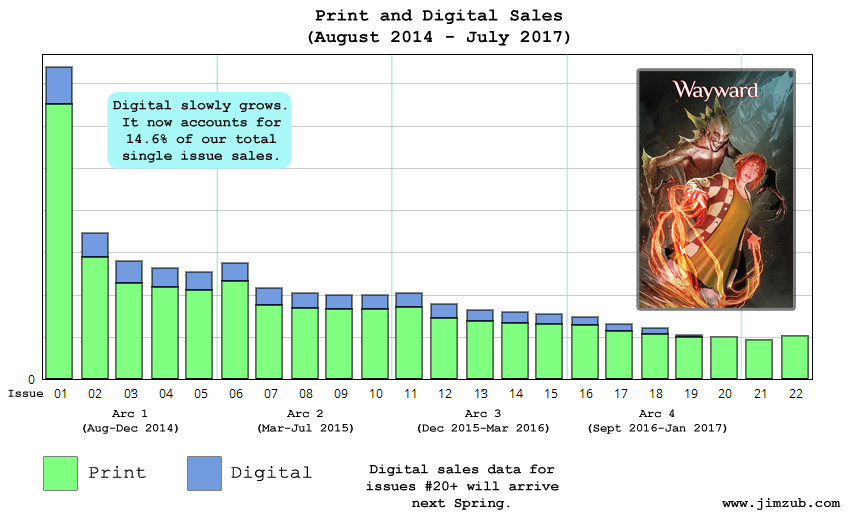Creator Jim Zub has been charting the sales on his Image published titles for a while now and he just gave an update on Wayward complete with the charts and graphs we are so in love with here:
Although the chart shows standard attrition, the real story is a bit more complex:
The simple truth is that the market has moved to trade reading. Affordable, durable, easy to lend to a friend or give as a gift, trade paperbacks are now the market for many titles. Wayward trade paperback sales continue to grow and that really drives us forward at this point. Direct market comic retailers support Wayward with their trade orders, but more than half of our trade sales now come from bookstores and other outlets. Initial direct market orders are pretty good, but the long tail of continued sales through other channels keeps us growing year after year. Good word of mouth from people like you keeps us going.
He also cites Image’s Humble Bundle promotion and the startling stat that “Tens of thousands of people have read Wayward Vol. 1 through the Unlimited platform.”
We’ve charted the impact of Humble Bundle here for a while – six figures profits in one go – but the Comics Unlimited effect is one no one has pointed out before. Something that bears watching.
As always read the whole thing, but I do want to highlight Zub’s takeaway – the comics market is not about monthly periodical sales any more:
If you take away anything from this post, let it be this: When fans or news sites only obsess over direct market single issue sales numbers from Comichron (which are not complete, but do provide an overall sense of market leaders and attrition), they are ignorant of a much larger overall market.Comic companies are not obligated to post their sales numbers, but that obfuscation has unfortunately led to a ridiculous amount of armchair quarterbacking by people who cannot see the forest for the trees and are woefully ill-informed about what sells and where. If you only looked at monthly print single issue sales you would assume Wayward was doomed over a year ago, but it’s just not true. The market has shifted and will continue to do so. Readers, retailers, and publishers need to adjust their perception of the market, if they haven’t already.
Zub is a smart creator who also has a head for the business end of things, but all of these trends are being taken advantage of by other creators who are clued in to the power of Kickstarter, digital and book channel sales. Anyne who says the market is dying is only seeing part of the picture.









No doubt there are many paths to profitability now. Hence the lower threshold for many titles sticking around in print. I would suspect that the digital and trade sales work best for these kind of contained stories (does the long tail help a book like Blue Beetle?).
I was recommended this blog via my cousin. I am not positive whether or
not this put up is written by him as no one else realize
such special about my problem. You are incredible! Thanks!
He also just posted a look at Skullkickers and it has more graphs! http://www.jimzub.com/creator-owned-economics-the-long-long-game/
So…was that SPY SEAL guy lying when he bluntly detailed a completely opposite experience with the comic market?
Let’s talk numbers.
How many people are making a living at comics in the Direct Market? How many people are making a living at comics outside the Direct Market? How many people are making a living with graphic novels? How many people are making a living with trades, WHICH REQUIRE THE EXISTANCE OF SERIALIZED COMICS? And how many people are making a living at online comics?
Let’s not be fooled by “survivor bias” because I can point to a guy named Kirkman as evidence that monthly comics remain an irreplaceable part of the industry.
Mike
Les pribadi di Jagoan Privat gurunya mantap abiss.
@ MBunge
Jim Zub’ story is not exactly one that I would call a «success story.» And I mean no offense to him. His first book, Skullkickers, sold a few thousand copies per issue (4-5k), and was never profitable as a monthly nook, and is new one, Wayward is on similar if a bit better levels (6k). If, with trades and digital, both his books managed turn profitable, one even 2 years after ending, I would say that, thanks to the Image model and new non super hero comics readers, more people can make a living in the Direct Market than probably ever.
Again, I am saying this not to undermine Zub accomplishment, but to underline that we are not talking of an exception like Walking Dead or Saga (indie books that sell 50-70k copies) but of one of the many under 10k indie books. And it seems that thanks to digital and trades even them can make money now.
Also, Gillien stated not too much time ago, that every Image book that sell 10k or more copies does well even without taking into consideration trades and digital. And that other under 10k books do as much well thanks to additional trades and/or digital sales. I see an average of 20-25 books that sell over 10k from Image every month, and considered that many books skips a few month between arcs, I think it’s safe to say at leas 40 Image books sell over 10k. I don’t think there ever been a moment in American comics history where more than 40 creator owned did for the creators as much or more money than working for Marvel or DC.
I don’t understand how the takeaway message is supposed to be about *digital* and *Comics Unlimited* when from the data and discussion Zub provided we learn the following:
-The graphs show that digital sales were never big and have now declined to basically nothing.
-Wayward Vol 1 has been made available to “tens of thousands” of readers via the all-you-can-eat Unlimited and Humble Bundle options. But how does that actually translate into revenue?…
…You’re basically giving away Vol 1. Which is nearly what Image already does with most of its series. Vol 1’s are $9.99 cover price and can also be found for 30%-50% off quite easily from many merchants. In other words the creators are only making a buck or two from Vol 1 TPB sales… but that’s fine because it’s a great way to potentially build an audience.,, IF the audience comes back for more after Vol 1.
So I’m not really seeing much encouraging information here. Wayward Vol 1 is apparently one of many titles that have been made available to many, many potential readers at a low cost, digitally. Where’s the follow-through, though? The very graphs he provides shows that digital copies have declined to almost nothing. So the tens of thousands of people who got Vol 1 for cheap/free digitally evidently didn’t become regular digital readers, or regular physical-copy readers.
@ Dan Ahn
You just need to learn how to read to understand. Digital sales of the issues grew from 10 to 14.6% of the total sales since the last update. You don’t see digital sales for the last issues because, as the graphic say, those data aren’t available yet, not because they didn’t sell. Digital sales of the collections have grown to 14% too.
Creator owned comics can scratch their producers a small income with constant work. Hooray!
Comments are closed.